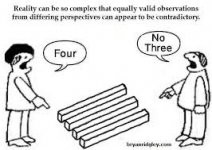No closed mind. I have already spent many hours trying to learn it, from dvd1 several years back to every single youtube clip Stan has online, plus a few other youtube clips from those who claim to know how it works. I only wasted this time because I view it as an unsolved puzzle. I did the same thing with the rubics cube and got to where I could work it within 1.5 minutes using my own logarithmic patterns. It's no world-record time, but I'm content with it. I'm also content with how I play pool and I'm not in the market to change a thing. The same way CTE users feel once they begin to consistently make it work. I'm all for doing what works for you. But also a curious type that enjoys learning.
I'm mainly curious because I don't see anything special about aiming with spheres. We aim using the equators of the balls, circle against circle, regardless of which aiming system or method one uses. These "perceptions" are simply visual relationships between two circles at different perspectives. The "objectivity" of using the system with any accuracy relies on player experience, which means it's not quite objective. But I don't want to start a big mud-slinging battle, so I'll just say maybe the book will prove the system's objectivity, and that would be great. But the system will have a place right there on my shelf alongside all those diamond kicking systems that I just haven't wanted to invest any time into learning.
Regardless, you can use ANY two circular objects (like hockey pucks or poker chips) and get the 15 30 45 "perceptions" and fire them into the holes using cte. Or you could use fractions, Samba, or whatever. They don't have to be spheres.

